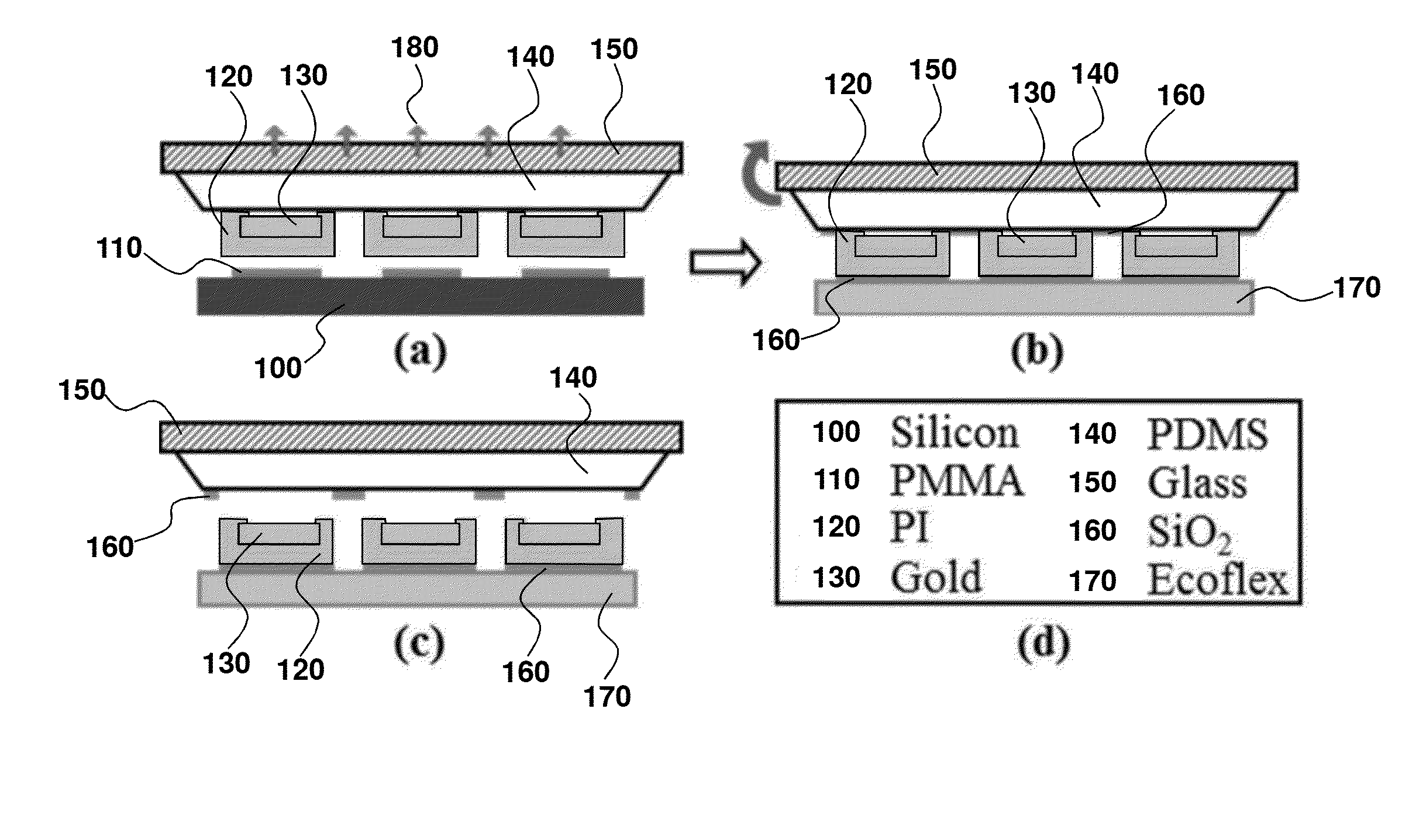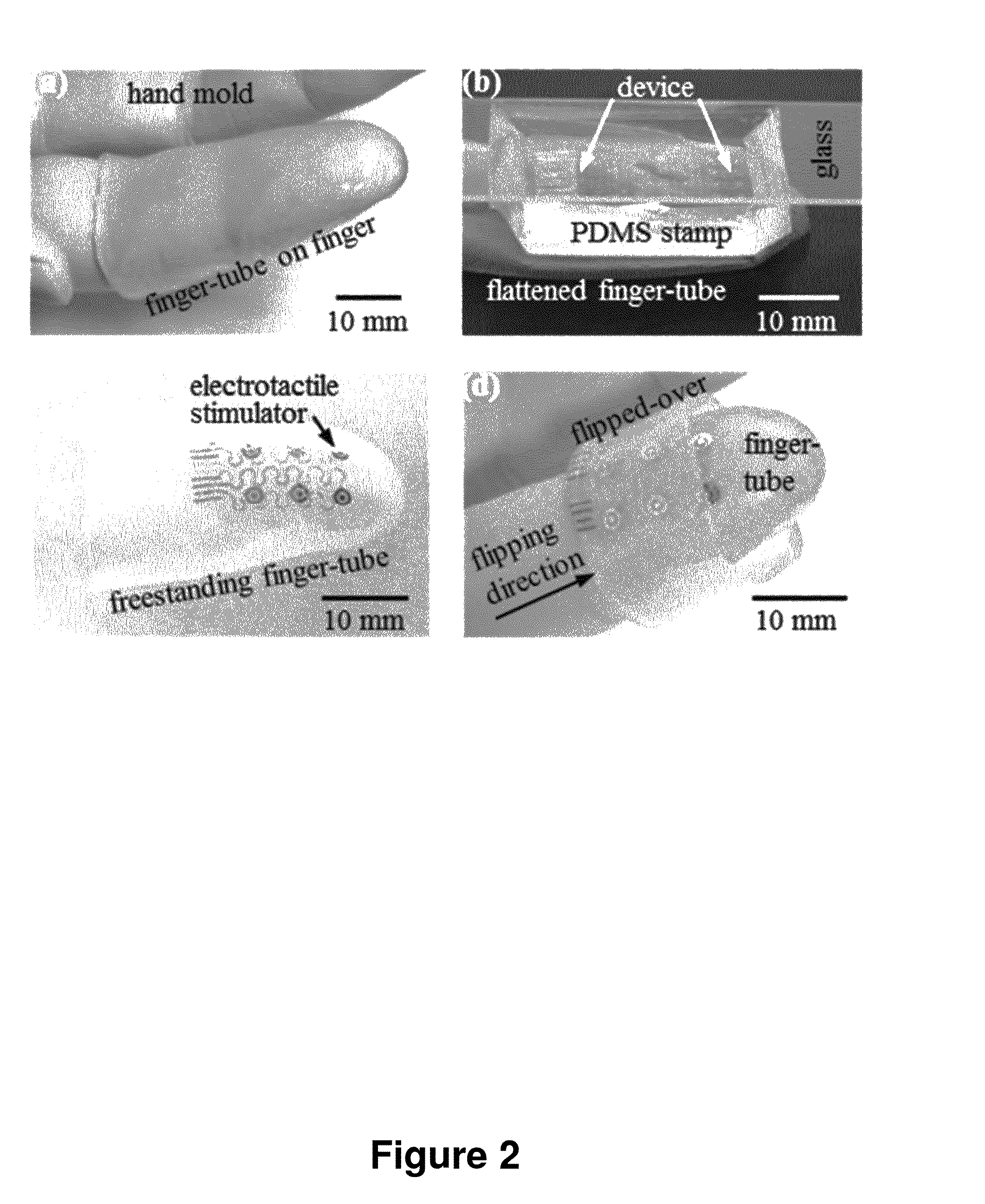Appendage Mountable Electronic Devices COnformable to Surfaces
a technology of electronic devices and surfaces, applied in external electrodes, surgical manipulators, surgical robots, etc., can solve the problems of difficult to reliably provide electronics on a correspondingly complex surface, poor application suited to clinical applications outside of research labs or clinical settings, etc., to reduce the volume of the enclosure, reduce the diameter of the enclosure, and reduce the fracture strain of the elastomeric substra
- Summary
- Abstract
- Description
- Claims
- Application Information
AI Technical Summary
Benefits of technology
Problems solved by technology
Method used
Image
Examples
example 1
Silicon Nanomembranes for Fingertip Electronics
[0200]This example relates to the use of semiconductor nanomaterials, advanced fabrication methods and unusual device designs for a class of electronics capable of integration onto the inner and the outer surfaces of thin, elastomeric sheets in closed-tube geometries, specially formed for mounting on the fingertips. Multifunctional systems of this type allow electrotactile stimulation with electrode arrays multiplexed using silicon nanomembrane (Si NM) diodes, high-sensitivity strain monitoring with Si NM gauges, and tactile sensing with elastomeric capacitors. Analytical calculations and finite element modeling of the mechanics quantitatively capture the key behaviors during fabrication / assembly, mounting and use. The results provide design guidelines that highlight the importance of the NM geometry in achieving the required mechanical properties. This type of technology is compatible with applications ranging from human-machine interf...
example 2
Methods of Making the Electronic Devices
[0215]1. Electrotactile Arrays:
[0216]a. Cut 1′×1′ SOI wafers ((110), 300 nm Si) and clean with acetone and IPA.
[0217]b. Form a 900 nm layer of SiO2 by PECVD as p-dope diffusion mask.
[0218]c. Pattern diffusion mask by: i. Pattern photoresist (PR) AZ5214: Spin coat PR AZ5214 (3000 rpm, 30 s), pre-bake (110° C., 1 min), align mask and expose, develop with MIF327 (40 s), post-bake (110° C., 3 min). ii. Wet etch with buffered oxide etchant (BOE) (NH4F: HF=6:1) for 1.5 min and remove PR with acetone.
[0219]d. P-type doping: i. Clean wafers with Nano-strip™ (Cyantek), place next to boron doping source, and put into furnace (1000° C.) for 30 min. ii. Etch SiO2 mask completely with HF (30 sec), and form another 900 nm layer of SiO2 by PECVD as n-dope diffusion mask. iii. Pattern diffusion mask: Same as 1c.
[0220]e. N-type doping: i. Clean wafers with Nano-Strip™, place next to phosphorous doping source at 1000° C. for 10 min. ii. Etch SiO2 mask completel...
example 3
Appendage Mountable Electronic Devices Conformable to Biological Surfaces
[0281]One example of an appendage mountable electronic system is schematically summarized in FIGS. 14-17, including an appendage corresponding to a finger or a finger-tip. Different views of an appendage mountable electronic system 10 is provided in FIG. 14(A-C), with a top view (A), a side cross-section view (B) and a cross-section viewed from an end (C). Referring to the different views of FIG. 14, the system 10 comprises a flexible and stretchable substrate 20 having an inner surface 30 and an outer surface 40. In this example, the electronic device 50 comprises a plurality of flexible or stretchable sensors 54 supported by the outer surface 40, and a plurality of flexible or stretchable actuators 55 supported by the inner surface 30. The electronic device further comprises various components to provide desired functionality and operating characteristics. For example, FIG. 14 illustrates electrical interconn...
PUM
| Property | Measurement | Unit |
|---|---|---|
| thickness | aaaaa | aaaaa |
| surface area | aaaaa | aaaaa |
| diameter | aaaaa | aaaaa |
Abstract
Description
Claims
Application Information
 Login to View More
Login to View More - R&D
- Intellectual Property
- Life Sciences
- Materials
- Tech Scout
- Unparalleled Data Quality
- Higher Quality Content
- 60% Fewer Hallucinations
Browse by: Latest US Patents, China's latest patents, Technical Efficacy Thesaurus, Application Domain, Technology Topic, Popular Technical Reports.
© 2025 PatSnap. All rights reserved.Legal|Privacy policy|Modern Slavery Act Transparency Statement|Sitemap|About US| Contact US: help@patsnap.com



